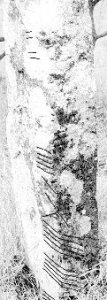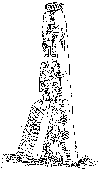Another stone from the St. Olan's church is no. {105} which was removed [when?] to the Cork U.C. The stone from "Mount Rivers" (no. {122}) was only secondarily placed beside St. Olan's well which is not more than 5 m. from Aghabullogue. According to Brash (109), "St. Olan does not appear in any of our calendars, his name is not on the stone".
The entire length of the monument is according to Brash (130), 6' 9". When visited in 1981, its lower part could not be checked because it was under ground.
Size according to Macalister, CIIC: 5'2" x 0'11 1/2" x 0'6 1/2".
Published photographs:
Macalister, Epig. 3, (to face) p. 128.
- Published illustrations:
- Brash, OIM pl. IX ("St. Olan's Church");
- Macalister, CIIC 1, 104 (draft);
- P.J. Hartnett, JCHAS 3, 2.ser., 1947, pl. 3 (to face p. 8), fig. 3.
- Macalister, CIIC 1, 104 (draft);
Reading Brash, OIM 130 ("St. Olan's Church, No.1"):
âêéïîìãòñ::òñõãïâîíææâðääììðõíí
ANMCOR R MAQ GUUDDG TT
Reading Ferguson, OI 92 (144.):
P e G a P
ANMCORREAMAQFUIDDaIBMuEATT
&c. &c.
Anm Corpimaq fuidd (e)g(u)ptt.
Reading Macalister, Epig. 3, 128:
âêéïîìãòñòñõïâîíéåääììææææïõíí
ANMCORRKMAQVIUDD METT
Reading Macalister PRIA 33, 1917, 81:
ANMCORRXMAQV..DD...MXTT
Reading Macalister CIIC:
ANM CORRE MAQVI UDD[GLO]METT
("UDD- .. and the concluding METT are clear .. but the intervening letters are fractured, worn smooth, and covered with lichen: the H-half of the G is the only part that can be certainly traced, and all that can be said for the restoration suggested is that it would just fit the gap".
Reading Gippert (1981):
 Angle up:
Angle up:
]C[ ]RREýA M(A)Q(V)[ ]D(D)[ ]MEýATT
]îì[ ]òñæòñõæï(â)îí(é)[ ]ì(ì)[ ]ïõíí[
]ëëëë[ ]ïïïïïæïïïïïõæï(â)ëëëëë(ççç)[ ](ââ)[ ]ì(ææì)[ ]ïõæëëëæëëë[
 between 2D and 2M, except a slanted stroke on the B-surface immediately below the M, which could represent a second M itself. - The gap
between 2D and 2M, except a slanted stroke on the B-surface immediately below the M, which could represent a second M itself. - The gap  between 1R and 2R would allow for restituting *CORBREýA, but there seems to be no indication of a B. - Every interpretation starting from Macalister's UDDGLOMETT is unjustified, given that this author's judgement was mostly dictated by the amount of empty space. If his V is right, we could think of a restoration as *VEDDEýALMMEýATT instead, thus yielding another example of the gen. of the name Fedelmid as attested in {206} as *VEDELMETT or on the Pilsworth stone {1972: McManus, Ogam, 72-74} as VEDDELLEMETTO (with secondary svarabhakti. Traces of at least an L letter seem conceivable, but 2D is not beyond doubt, and the space
between 1R and 2R would allow for restituting *CORBREýA, but there seems to be no indication of a B. - Every interpretation starting from Macalister's UDDGLOMETT is unjustified, given that this author's judgement was mostly dictated by the amount of empty space. If his V is right, we could think of a restoration as *VEDDEýALMMEýATT instead, thus yielding another example of the gen. of the name Fedelmid as attested in {206} as *VEDELMETT or on the Pilsworth stone {1972: McManus, Ogam, 72-74} as VEDDELLEMETTO (with secondary svarabhakti. Traces of at least an L letter seem conceivable, but 2D is not beyond doubt, and the space  between V and 1D seems to large to contain but the four notches of one E. Should we suppose a second V in the beginning of the name? Like this, we should arrive at the following interpretation:
between V and 1D seems to large to contain but the four notches of one E. Should we suppose a second V in the beginning of the name? Like this, we should arrive at the following interpretation:
[ANM] CORREýA MAQ V[VE]D(D)[EL]MEýATT
Last changes of this record: 26.04.97
Copyright Jost Gippert, Frankfurt a/M 1996. No parts of this document may be republished in any form without prior permission by the copyright holder.









